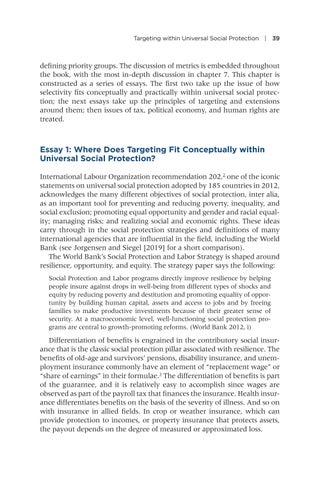Targeting within Universal Social Protection | 39
defining priority groups. The discussion of metrics is embedded throughout the book, with the most in-depth discussion in chapter 7. This chapter is constructed as a series of essays. The first two take up the issue of how selectivity fits conceptually and practically within universal social protection; the next essays take up the principles of targeting and extensions around them; then issues of tax, political economy, and human rights are treated.
Essay 1: Where Does Targeting Fit Conceptually within Universal Social Protection? International Labour Organization recommendation 202,2 one of the iconic statements on universal social protection adopted by 185 countries in 2012, acknowledges the many different objectives of social protection, inter alia, as an important tool for preventing and reducing poverty, inequality, and social exclusion; promoting equal opportunity and gender and racial equality; managing risks; and realizing social and economic rights. These ideas carry through in the social protection strategies and definitions of many international agencies that are influential in the field, including the World Bank (see Jorgensen and Siegel [2019] for a short comparison). The World Bank’s Social Protection and Labor Strategy is shaped around resilience, opportunity, and equity. The strategy paper says the following: Social Protection and Labor programs directly improve resilience by helping people insure against drops in well-being from different types of shocks and equity by reducing poverty and destitution and promoting equality of opportunity by building human capital, assets and access to jobs and by freeing families to make productive investments because of their greater sense of security. At a macroeconomic level, well-functioning social protection programs are central to growth-promoting reforms. (World Bank 2012, i)
Differentiation of benefits is engrained in the contributory social insurance that is the classic social protection pillar associated with resilience. The benefits of old-age and survivors’ pensions, disability insurance, and unemployment insurance commonly have an element of “replacement wage” or “share of earnings” in their formulae.3 The differentiation of benefits is part of the guarantee, and it is relatively easy to accomplish since wages are observed as part of the payroll tax that finances the insurance. Health insurance differentiates benefits on the basis of the severity of illness. And so on with insurance in allied fields. In crop or weather insurance, which can provide protection to incomes, or property insurance that protects assets, the payout depends on the degree of measured or approximated loss.


